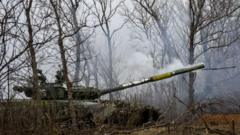In a highly anticipated meeting in Alaska, US President Donald Trump and Russian President Vladimir Putin concluded their summit without attaining a ceasefire agreement for Ukraine. The nearly three-hour discussion resulted in a joint statement delivered to the press, but left many questions unanswered.
Reflecting on the summit dynamics, Trump remarked, "There's no deal until there's a deal," suggesting an admission of the unsuccessful negotiations that unfolded. Despite declaring that progress was made, specifics were scarce, leading to skepticism among both domestic and international observers. Trump's journey to Alaska ended with him unable to secure any substantive outcomes that could be hailed as victories.
The repercussions for Trump may extend beyond this solitary meeting, potentially impacting his reputation as a skilled negotiator. His past assertions highlighting a low probability of failure made the aftermath even more challenging, considering the expectations set before the summit. Furthermore, reports indicate that Trump refrained from questioning Putin during a joint media appearance, a departure from typical protocol that could fuel criticism of his diplomatic approach.
On the Russian side, Putin enjoyed a moment of prominence on the international stage but did not bend to Trump's requests for a ceasefire. Instead, he maintained a strong stance on the conflict, reiterating the "root causes" of the ongoing war, a signal of his persistent intentions regarding Ukraine's independence.
For Ukraine, while the absence of a "deal" may elicit some relief, the prevailing tension and uncertainty about future Russian aggression remain significant concerns. Observers note a tangible fear that without clear negotiations or consequences for Russia, the conflict may intensify, further jeopardizing Ukraine's sovereignty. As questions loomed about the implementation of potential sanctions, fears linger regarding the next steps in this protracted conflict.


















